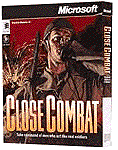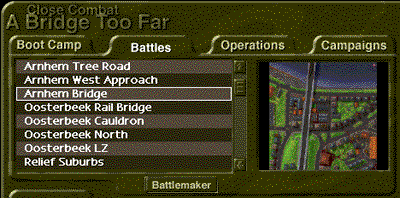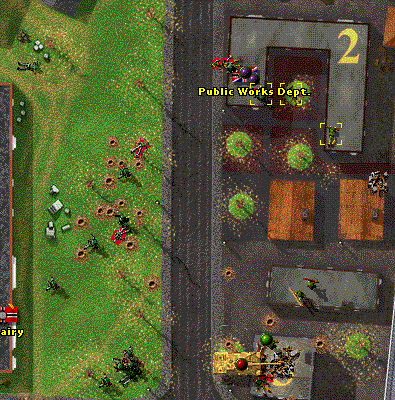Review: Close Combat: A Bridge Too Far

 Product Information
Product Information
Publisher: Microsoft
Web: <http://www.microsoft.com/games/>
Category: Game, World War 2 Real time tactical
Programming & Design: Atomic software
Web: <http://www.atomic.com/games/ccmain.html>
Street Price: $50
System Requirements
Power Macintosh
Mac OS 7.5 or higher
16 MB RAM
40 MB hard disk space
4x CD-ROM
800x600 Monitor
Thousands of Colors
Networking: 2 player over modem (28.8kbps minimum speed) or TCP/IP
Before you fire up Atomic's "Close Combat: A Bridge Too Far," you might want to dust off a copy of Cornelius Ryan's book, A Bridge Too Far, or visit your local video store to rent the movie of the same name to put you in the mood. This game covers a series of battles in the largest airborne operation of the Second World War--an operation which, like the name implies, failed through an underestimation of the defenders and an overly optimistic set of objectives. The combination of elite troops from four nationalities, the urgency of the operation and consequent rescue mission, the close nature of the fighting, and the wide range of equipment used mean that the battles are action-packed and exciting.
 Close Combat: A Bridge Too Far takes the basic engine that drove the award winning predecessor, "Close Combat," and makes it a more polished product, gaining some improvements, but simultaneously dropping one or two things that might be sorely missed by avid devotees of its predecessor. The scale is operational, yet micro-tactical, as you can allocate reinforcements between divisional airdrops, yet command bazooka teams to hunt down German tanks. Each battle has a mission--fail this mission and you will be forced back to defend on new ground. Succeed, and you can push the enemy back, or you might be forced to again defend your territory from another assault.
Close Combat: A Bridge Too Far takes the basic engine that drove the award winning predecessor, "Close Combat," and makes it a more polished product, gaining some improvements, but simultaneously dropping one or two things that might be sorely missed by avid devotees of its predecessor. The scale is operational, yet micro-tactical, as you can allocate reinforcements between divisional airdrops, yet command bazooka teams to hunt down German tanks. Each battle has a mission--fail this mission and you will be forced back to defend on new ground. Succeed, and you can push the enemy back, or you might be forced to again defend your territory from another assault.
To achieve your missions, you command a selection of fire-teams of paratroopers, infantry, tanks, tank destroyers, anti-tank guns, and a range of other armoured vehicles. Attacks can be screened from your opponent (computer or human) by the use of mortars or guns firing smoke, or your support troops can lay down covering fire to keep the opponent's troops' heads down. Like its predecessor, all of this is animated, with men and tanks firing, men crawling forward through fields, the wounded lying bleeding on the ground, and your body chilling at the sight and sound of flame-throwers spewing gouts of fire at their targets. Hand to hand combat is shown as tiny graphics of men parrying and attacking their opponents with accompanying grunts and thuds until only one side remains standing. Brief lines of fire flash on the map to show you where firing is coming from and going to; your fire is shown in blue and your enemy's in red.

I would have to say that the battlefield maps are the most beautiful I have yet seen in a computer war game. Roads sweep around bends, the plowed fields are still green with growth, trees show their fall colors, and every building is unique. This battlefield is not a chessboard with neatly laid out rows of houses and hedges, instead each map is individually drawn, colored, and shaded to make it look like a view from a plane, including the shadows cast by all objects. But there is more: Atomic Games has added in the complexity of height and elevation. Buildings over one storey tall are now depicted with a '2,' '3,' or even a '4' on their roof, indicating their height advantage over the surrounding countryside. This height advantage not only allows troops occupying them to see further, but fire directed at them is diminished according to the height of the building they occupy. When troops occupy a building, the building is shown with its roof removed and the troops are shown inside. Damage done to buildings is carried over from one battle to the next if you are playing a Campaign game, so that after a few game days some houses lie wrecked. Like the name of the game implies, much of the fighting is centred around bridges or fighting for their control, and the bridges are handled well graphically. The German player, on some missions, has the ability to blow up his bridge before it falls into the hands of the American or British troops and can make the bridge blow up with a satisfactory explosion and falling wreckage.

There are only a small number of commands available to a player's troops: move, move fast, sneak, fire, make smoke, defend, and hide. These commands are deceptively simple, since their effects depend on where they are applied. Firing at a visible enemy will allow that enemy to be tracked and shot at even if they move, while firing at a suspicious location will allow you to maintain that covering fire indefinitely, or at least until you run out of ammunition. The new command 'sneak' allows you to creep through fields and woods in your attacks, or to slip away from a defensive position without making it obvious. One command missing is the 'Defend this arc' command, so sometimes you have to ask your troops to move, then cancel that move partway through to get the same effect. If you have accidentally left a squad hiding in a building when the enemy approaches, the computer's Artificial Intelligence (AI) will not allow them to be taken by surprise and they will ambush the enemy when it gets too close.
A good AI is hard to program well, but Atomic has managed to do a good job and has improved on the model first seen in the original "Close Combat." As expected, the computer plays the defending Germans much better than it does the Allied attackers, since there are less complex decisions that it has to make. You will still be surprised by the apparent intelligence of your computer opponent, but the best opponent is still another human, either on the Internet or via modem.
For the purists, there are some inaccuracies in the information used in the game, such as an armoured car that seems to contain a warehouse's store of ammunition, but most of these are minor or can be fixed by editing the data files with a spreadsheet. Two official patches have been released since version 1.0 was released, and these have tuned the troop behaviours to make the tanks less fickle and wild. Personally, I treat the sometimes-weird behavior of tanks as part of the independent and unreliable nature of the armoured support of that period. Just keep in mind it is still just a game, and you don't need to control every footstep of every soldier to win.
Winning the campaign requires you to allocate resources to each sector of the campaign; before each battle you can use these resources to buy extra troops or tanks to assist each mission. If they survive, you get them for the next mission. As you win more missions, you are awarded more resources which represent the extra reinforcements available from landing grounds or supply lines.
The immense amount of work that Atomic put into making their wonderful maps has meant that there have not been the same third-party expansion maps and scenarios. We have been provided with a scenario editor by the folks at Atomic which allows us to set up the existing maps and troops in a huge number of different scenarios. Atomic has even provided us some tanks and troops that were not available during the real "Market Garden" operation for these custom games.
Compared to the manual for its predecessor, the game manual is quite short, and the game relies to a large extent on the online tutorial and help system, which is excellent. Still, there is no substitute for trying out various tactics.
To win, you need to learn the lessons of how to combine infantry, tanks, and guns in a coordinated plan of attack and defence--although you don't really have to know a lot about military history. As you can set the game difficulty to account for various experience and abilities, Atomic has made a game that can be enjoyed by the novice as well as the experienced player. You can download a single-battle 6.7 MB demo from Atomic's web site to see if you like it. Highly recommended for all those who remember playing with toy soldiers when young.
![]() Copyright © 1998 Bill Lee, <billlee@asia.apple.com>. Reviewing in ATPM is open to anyone. If you're interested, write to us at <reviews@atpm.com>.
Copyright © 1998 Bill Lee, <billlee@asia.apple.com>. Reviewing in ATPM is open to anyone. If you're interested, write to us at <reviews@atpm.com>.
Reader Comments (9)
[email protected]
Reyth
Add A Comment